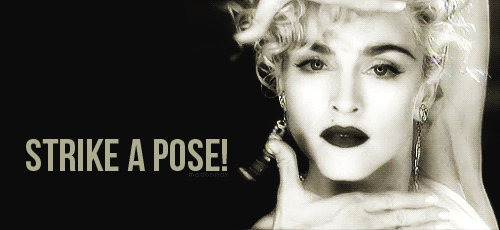 “Strike a pose
“Strike a pose
Strike a pose
(vogue, vogue, vogue)
(vogue, vogue, vogue)…
When all else fails and you long to be
Something better than you are today.”
– Madonna, Vogue (1990)
Challenge:
Anna Wintour, Vogue magazine’s editor-in-chief and one of the most famous women in the fashion world once said, “You are nothing, nothing, without a good team. So I have always tried to surround myself with people that I enjoy – people whose opinions I respect, whose minds I respect, whose taste I respect, that isn’t always in line with mine.”
According to Merriam-Webster dictionary, the word “vogue” means “one that is in fashion at a particular time.”
“At a particular time.” Fashions change for two reasons – 1. people change and 2. people have to stay relevant. People get bored quickly and are influenced by popular culture, including athletes, musicians, movie stars, social media, and royalty. They also pay attention to what people wear in their favorite Netflix series, YouTube videos, books, and music.
Fashion doesn’t stay vogue by doing the same things over and over again. Instead, fashion icons are always searching for a new angle to maintain their popularity.
Leadership is very similar. As Chris says, “successful leaders can’t just go through the motions.” Trends change over time and successful leaders are proactive about it. Today, you are most likely a different leader than you were five years ago and, when successful, you will be an even more evolved leader ten years from now.
Psychological Principle:
In psychology, the term “modeling” means learning by copying the behavior of someone else. Humans naturally model each other – for example, children use modeling to learn how to use a fork or tie their shoes. Initially developed by Albert Bandura beginning in the 1960s, modeling in psychology has become a mainstream theory used in both business and personal relationships. Research shows that employees are watching how their leaders handle the most difficult situations with the most intensity. Employees are looking at their leaders to see how they respond to the tough stuff.
Also, in psychology, there is a term called “morbid curiosity” – a psychological trait that makes people overly curious when bad things are happening. In short, your staff will be watching when things get tough. Let them watch – but make sure they are also watching your positive response. Below are the 7 difficult situations that staff are watching the most:
- Your team’s “quiet quitting” culture – “Quiet quitting” has gotten a lot of press lately. Basically, it is the idea in which employees work within defined work hours and engage in work-related activities solely within those hours – no extras. You are the leader of your team so you set the tone around work responsibilities, overtime, expectations to work on weekends, etc. If you are “quiet quitting” you better believe that your staff will follow suit.
- A key employee resigns – Few things frazzle a leader faster than receiving a resignation letter from a key team member. If you demonstrate confidence and resilience and keep your team in the loop, they will have less anxiety around the departure. If you demonstrate a “sky-is-falling” mentality and keep them out of the details, they’ll panic and potentially cause more resignations.
- You let an employee go – Firing someone, for whatever reason, is always stressful and brings about a culture of fear and defensiveness. Employees always watch how you treat employees that are no longer a good fit for your company. When handled professionally and compliantly, a termination can still lead to cordial relationships. Think about the example you want to set for your team.
- You’ve lost a big contract/customer – Group morale can be crushed when a team doesn’t win a contract or customer. Of course your employees will be upset, and will also expect you to be upset. However, they will also look to you to answer “what’s next.” You must demonstrate you still believe in them and their talents and that you want to learn from this “failure.”
- You’ve won something big – When an award comes in, employees will look to the leader for direction on how the team will take on the new work. They’ll also be watching how the leader acknowledges the people in the organization that contributed to the win. All wins should represent a collaborative effort and every effort should be publicly acknowledged. No one wants to feel overlooked. Nothing disengages an employee faster than a lack of appreciation.
- You’re hiring a new employee to the team – Leaders must not underestimate the importance of the first-day impression. This will set the tone for how the new employee feels about the company, and how they fit into the bigger picture. Be sure to prep their workspace, assign a mentor, and check in often to see if they have any questions. Leaders should personally reach out to welcome all new hires.
- You’ve failed – You’ve messed up. You’re human. You will hire the wrong person. You will yell. You will fail. Employees don’t expect perfection, but they do expect accountability and ownership. Own up to your mistakes. Don’t blame others. Look for the opportunities to learn.
Mindset Shift:
- Your team is watching you – Leaders lead by example, whether they intend to or not. Your team will do what you demonstrate far faster than they will do what you say. That means that if you’re in a leadership position and your words and actions do not match then others will follow your actions, not your words.
- Be a model – strike a pose and let them follow your lead!
Performance Shift:
- Pick the right person to model – Look for someone who is already successful in your chosen field, or someone who has created the kind of life you want to live. How did they get to where they are today? Use this information to build a path that mirrors theirs.
- Ask for help – No matter what it is you’re after, someone has already beaten you to it. If it’s someone you already know or have a connection to, even better. You don’t just have to study them from afar to learn how they found the key to success; you can ask them to share their experiences with you or even mentor you. Understand that their time is valuable and offer a way to add value to their life while they assist you. If this is a friend, it could be as easy as taking them to dinner every month. If it’s an acquaintance, perhaps you’ll take on extra yard work or provide technical assistance. Utilize your coach through Chris Flickinger Performance Mindset and Development to help you!
- Be a mentor and model for your team members – Tell them that they can come to you. Keep them in the loop when you handle the difficult situations!
- Create a strategic plan around it – Those who have succeeded before you have done so because they followed a plan, and you can do the same thing.
Leadership is complex and difficult. However, with self-awareness in our most challenging times, we are given the opportunity to inspire others with our resilience, focus, and strength. This is what we do everyday. We show managers and leaders how to “strike a pose” and be a model at work. If you want to learn more about how your work can add more value and explore better ways to be productive, reach out to Chris!
Follow Chris on Social Media!















0 Comments